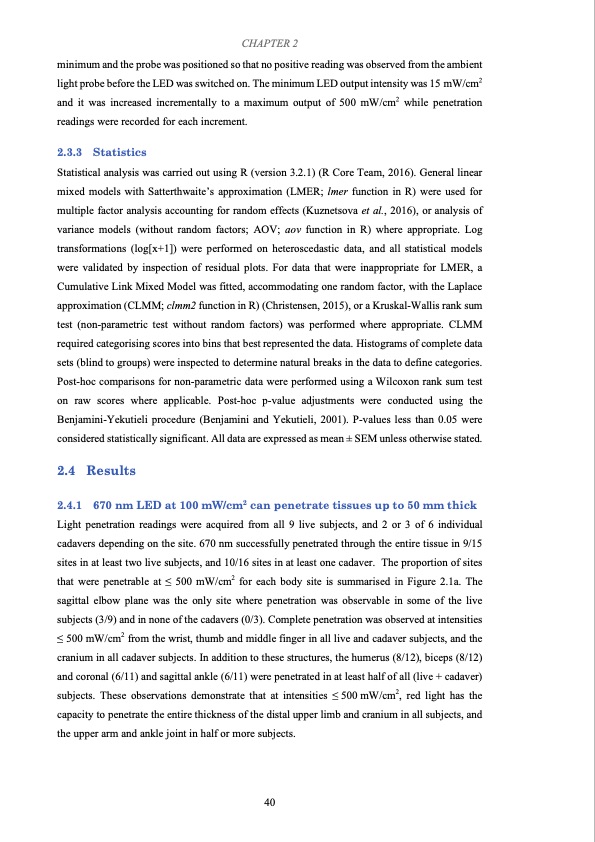
PDF Publication Title:
Text from PDF Page: 054
CHAPTER 2 minimum and the probe was positioned so that no positive reading was observed from the ambient light probe before the LED was switched on. The minimum LED output intensity was 15 mW/cm2 and it was increased incrementally to a maximum output of 500 mW/cm2 while penetration readings were recorded for each increment. 2.3.3 Statistics Statistical analysis was carried out using R (version 3.2.1) (R Core Team, 2016). General linear mixed models with Satterthwaite’s approximation (LMER; lmer function in R) were used for multiple factor analysis accounting for random effects (Kuznetsova et al., 2016), or analysis of variance models (without random factors; AOV; aov function in R) where appropriate. Log transformations (log[x+1]) were performed on heteroscedastic data, and all statistical models were validated by inspection of residual plots. For data that were inappropriate for LMER, a Cumulative Link Mixed Model was fitted, accommodating one random factor, with the Laplace approximation (CLMM; clmm2 function in R) (Christensen, 2015), or a Kruskal-Wallis rank sum test (non-parametric test without random factors) was performed where appropriate. CLMM required categorising scores into bins that best represented the data. Histograms of complete data sets (blind to groups) were inspected to determine natural breaks in the data to define categories. Post-hoc comparisons for non-parametric data were performed using a Wilcoxon rank sum test on raw scores where applicable. Post-hoc p-value adjustments were conducted using the Benjamini-Yekutieli procedure (Benjamini and Yekutieli, 2001). P-values less than 0.05 were considered statistically significant. All data are expressed as mean ± SEM unless otherwise stated. 2.4 Results 2.4.1 670 nm LED at 100 mW/cm2 can penetrate tissues up to 50 mm thick Light penetration readings were acquired from all 9 live subjects, and 2 or 3 of 6 individual cadavers depending on the site. 670 nm successfully penetrated through the entire tissue in 9/15 sites in at least two live subjects, and 10/16 sites in at least one cadaver. The proportion of sites that were penetrable at ≤ 500 mW/cm2 for each body site is summarised in Figure 2.1a. The sagittal elbow plane was the only site where penetration was observable in some of the live subjects (3/9) and in none of the cadavers (0/3). Complete penetration was observed at intensities ≤ 500 mW/cm2 from the wrist, thumb and middle finger in all live and cadaver subjects, and the cranium in all cadaver subjects. In addition to these structures, the humerus (8/12), biceps (8/12) and coronal (6/11) and sagittal ankle (6/11) were penetrated in at least half of all (live + cadaver) subjects. These observations demonstrate that at intensities ≤ 500 mW/cm2, red light has the capacity to penetrate the entire thickness of the distal upper limb and cranium in all subjects, and the upper arm and ankle joint in half or more subjects. 40PDF Image | Effects of Red Light Treatment on Spinal Cord Injury

PDF Search Title:
Effects of Red Light Treatment on Spinal Cord InjuryOriginal File Name Searched:
Thesis_Di Hu_final.pdfDIY PDF Search: Google It | Yahoo | Bing
Cruise Ship Reviews | Luxury Resort | Jet | Yacht | and Travel Tech More Info
Cruising Review Topics and Articles More Info
Software based on Filemaker for the travel industry More Info
The Burgenstock Resort: Reviews on CruisingReview website... More Info
Resort Reviews: World Class resorts... More Info
The Riffelalp Resort: Reviews on CruisingReview website... More Info
| CONTACT TEL: 608-238-6001 Email: greg@cruisingreview.com | RSS | AMP |